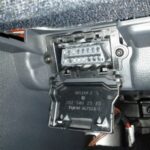The OBD2 port on your Kia is a gateway to a wealth of information about your vehicle’s performance, health, and potential issues. Using a Kia Obd2 scanner can empower you to understand your car better, potentially saving you time and money on repairs. This article explores how OBD2 works with Kia vehicles and what you can do with this technology.
Understanding Kia OBD2: How it Works
OBD2, or On-Board Diagnostics II, is a standardized system that allows external devices to access diagnostic information from a vehicle’s computer. All Kia models manufactured since 1996 are equipped with OBD2 ports, typically located under the dashboard on the driver’s side.
An OBD2 scanner, whether a dedicated device or a smartphone app with a compatible adapter, connects to this port and communicates with the car’s Engine Control Unit (ECU). The ECU monitors various sensors throughout the vehicle, collecting data on engine performance, emissions, and other critical systems. This data is then made available through the OBD2 port.
Diagnosing Issues with a Kia OBD2 Scanner
One of the primary uses of a Kia OBD2 scanner is to diagnose problems. When the ECU detects a malfunction, it stores a Diagnostic Trouble Code (DTC), commonly known as an error code, in its memory. By reading these codes with an OBD2 scanner, you can pinpoint the source of the issue.
A good Kia OBD2 scanner will not only display the DTC but also provide a description of the problem. Some advanced scanners even offer potential causes, troubleshooting tips, and predicted symptoms. This information can be invaluable in determining the necessary repairs. For example, a P0420 code on a Kia often indicates a problem with the catalytic converter.
Beyond Diagnostics: Real-Time Data with Kia OBD2
Modern Kia OBD2 scanners offer more than just diagnostic capabilities. They can also display real-time data from various sensors, providing valuable insights into your vehicle’s performance. This data can include:
- Engine RPM: Monitor engine speed.
- Vehicle Speed: Track your current speed.
- Coolant Temperature: Ensure the engine is operating at the optimal temperature.
- Fuel Pressure: Monitor fuel system health.
- Oxygen Sensor Readings: Assess emissions efficiency.
Accessing this real-time data allows you to monitor your Kia’s performance and potentially identify developing problems before they become major issues.
Choosing the Right Kia OBD2 Scanner
There is a wide variety of Kia OBD2 scanners available, ranging from basic code readers to professional-grade diagnostic tools. When selecting a scanner, consider your needs and budget.
- Basic Code Readers: Affordable options that display DTCs.
- Smartphone Apps with Adapters: Cost-effective solutions that offer code reading and real-time data display.
- Professional Scan Tools: Comprehensive diagnostic platforms with advanced features for experienced technicians.
Ensure compatibility with your Kia model and consider features like live data streaming, data logging, and manufacturer-specific code definitions.
Conclusion: Empower Yourself with Kia OBD2
Utilizing the power of Kia OBD2 can transform your relationship with your vehicle. Whether you’re a DIY enthusiast or simply want to be more informed about your car’s health, an OBD2 scanner is an invaluable tool. From diagnosing check engine lights to monitoring real-time performance, understanding and utilizing Kia OBD2 empowers you to maintain and understand your vehicle better.
